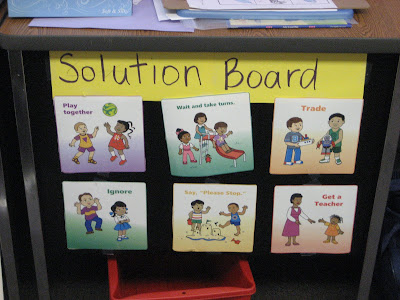Last year my pre-k program was moved to another elementary school in my district. I had a choice to move with my program or teach a different grade level at the current school. I chose to move.
Since it was a district decision to move the program, they provided staff to physically move all of the boxes and furniture, but I was responsible for the packing and the unpacking.
When I walked into my classroom after the movers had all of the boxes placed, I knew I had my work cut out for me. This is one of the before shots:

Clearly, I had to figure out a plan of attack to get everything organized and ready for the first day of school. I started with my necessities: iPod, coffee and Gatorade and then got to work.

I organized my actions by prioritizing what HAD to be in place for the first day of school and what materials I would be using. I keep most of my units of study in large Rubbermaid tubs with labels. You don't see it in the picture, but in one corner of the classroom is a storage room.
I needed to to get some space in the room to move the furniture, so I started by taking all of the tubs for my units and organizing them in the storage room. Once that was done, I could push the tables to the middle of the room, put all of the other materials on and under the tables and start working on the physical layout of the perimeter of the room. Here's the start of that:

Thinking about the physical layout is HUGE! Your physical layout in the classroom can either help you diffuse problems or can actually make the problems worse. The following are some of the things I think about as I set up a new room:
What is age/grade appropriate?
What areas need to be included?
Where are materials stored for the teacher, assistant, students?
How are materials accessed? Does it support independence?
Is there a quiet space when needed?
Where are the electrical outlets and computer drops?
Traffic patterns to and from:
- bathroom and fountain
- backpacks and lunchboxes
- time out, chill out chair, etc (if needed)
- teaching tables and support materials
- fire exit and alternate routes
- line up
And most importantly,
- Do I have visual supervision of all areas at all times?
At this point, I started moving centers around, figuring out how to address all of those questions regarding the physical layout and then unpacking materials that belong in each center.
It finally came together like this:

After living with it for a year, there are some changes that I'll make when I go back into school next week. But, I have found by thinking about the physical layout questions, I can address the most important issues first and do so efficiently....without having to do tasks twice because I "forgot" I needed to have a computer table near the computer drop or that I needed a wall for my housekeeping unit because it is too high to see over.
Moving and organizing a new room takes an enormous amount of energy and time. (That's why this post did not get posted last year when I actually moved! I was too busy attending to other things.) Make sure to ask your principal, department chair or mentor what is your responsibility and what the school/district provides. In the course of fifteen years of teaching I probably had to move classrooms 6 or 7 times before I found out that the district would provide boxes and I earned a comp day for moving. It took 3 days to organize my classroom last year. While the district didn't pay me for every bit of time I spent in there, it sure was nice to enjoy that day off that I did earn!
If you are moving or re-organizing your classroom this year good luck!








